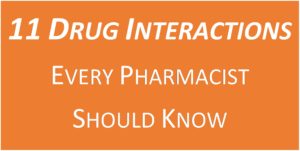An emerging field of practice for pharmacists is emergency medicine. Emergency Pharmacist deals with emergency drugs. The Centers for Disease Control and Prevention (CDC) states that there were 130.4 million visits to the emergency department (ED) in 2013.
Following below are the key role of an emergency pharmacist.
- Direct Patient Care Rounds
- Medication Order Review
- Medication Therapy Monitoring
- Patient Care Involving High-Risk Medications and Procedures
- Resuscitation ( Pharmacists prepare medications for immediate administration)
- Medication Procurement and Preparation
- Medication Information
- Documentation
Emergency drugs may be divided into two categories. The first category is drugs that are essential and should be part of every emergency drug kit. The second category consists of drugs that are useful but are optional depending on the practitioner’s training in emergency medical procedures and whether sedation and general anesthesia are used for behavior and anxiety management. Thus, emergency drug kits will vary from office to office.
1. Acetylcysteine
MOA:
Replenishes glutathione stores serves as glutathione substitute and enhances sulfate conjugation of acetaminophen (Tylenol)
PO Dose:
140 mg/kg x 1, then 70 mg/kg q 4 hours x 17 doses (72 hours total)
IV Dose:
150 mg/kg in 200ml D5W over 1 hour, 50 mg/kg in 500ml D5W over 4 hours, 100 mg/kg in 1 liter D5W over 16 hours (21 total hours, may need to continue until LFTs and APAP level normalize)
Emergent Indications:
Acetaminophen (Tylenol) overdose
Where you’ll get in Trouble:
Hypersensitivity reaction (stop infusion, switch to PO or slow infusion rate), while rare, you can also see hypersensitivity with PO as well, Preg B
2. Atropine
MOA:
Direct anticholinergic
Dose:
Organophosphate/carbamate toxicity: 1-6 mg IV q 3-5 minutes PRN, until dry secretions (can double dose each time until adequate response achieved) Peds Bradycardia: 0.02 mg/kg IVx1; 0.5 mg maximum single dose; 1 mg max cumulative dose Adult bradycardia: 0.5 mg IV, 3 mg max cumulative dose
Emergent Indications:
Organophosphate/carbamate toxicity, bradycardia
Where you’ll get in Trouble:
Hyperthermic patients, tachydysrhythmias, Preg C
3. Diazepam
MOA:
Enhances inhibitory effects of GABA
Dose:
2-10 mg PO/IV/IM q 6 hours PRN
Emergent Indications:
Seizure abortion, alcohol withdrawal, agitation, muscle spasm
Where you’ll get in Trouble:
Respiratory depression, hypotension, Preg D
4. Diltiazem
MOA:
Inhibits calcium influx in myocardium > vascular smooth muscle; prolongs AV nodal conduction
Dose:
0.25 mg/kg IV x1; may give 0.35 mg/kg IV x1 after 15 minutes; continuous infusion 5-15 mg/hr
Emergent Indications:
Stable Afib with RVR, stable SVT
Where you’ll get in Trouble:
Latrogenic hypotension, bradycardia, Preg C
5. Epinephrine
MOA:
Alpha and beta-receptor agonist
Dose:
ACLS: 1 mg 1:10,000 IV PALS: 0.01 mg/kg 1:10,000 IV Anaphylaxis: 0.1-0.5 mg 1:1,000 IM/SQ (IM preferred) Peds anaphylaxis/asthma: 0.01 mg/kg 1:1,000 IM/SQ (max single dose 0.3 mg) Hypotension refractory to IVF: 1-10 mcg/min IV
Emergent Indications:
Anaphylaxis, ACLS arrest, PALS/NRP arrest, severe asthma
Where you’ll get in Trouble:
Dosing errors (10 fold errors), tissue necrosis (needs to administer via central venous line), dysrhythmias, Preg C
6. Esomeprazole
MOA:
Inhibits parietal cell hydrogen-potassium ATPase (PPI)
Dose:
80 mg IV bolus followed by 8 mg/hour Emergent Indications: Upper GI bleed (non-variceal)
Where you’ll get in Trouble:
Fairly benign when used acutely, Preg B
7. Furosemide
MOA:
Inhibits Na and Cl reabsorption in the distal renal tubule and ascending loop of Henle
Dose:
The usual dose in ED 20-40 mg IV, reassess, increase to desired effect (maximum single dose 200mg)
Emergent Indications:
Pulmonary edema, CHF exacerbation, hyperkalemia (if making urine)
Where you’ll get in Trouble:
Volume depletion, hypokalemia, metabolic alkalosis, ototoxicity, Preg C
8. Fomepizole
MOA:
Inhibits alcohol dehydrogenase
Dose:
15 mg/kg IV loading dose, then 10 mg/kg q 12 hours x 4 doses, then 15 mg/kg q 12 hours until ethylene glycol levels < 20 mg/dL and patient asymptomatic with normal pH
Emergent Indications:
Methanol or ethylene glycol toxicity
Where you’ll get in Trouble:
Fairly safe, Preg C
9. Glucagon
MOA:
Stimulates cAMP production independent of the beta receptor, increases gluconeogenesis and glycogenolysis
Dose:
Beta-blocker/Ca channel blocker toxicity: 3-10 mg IV loading dose, then 1-10 mg/hour IV continuous infusion if responsive to loading dose Hypoglycemia: 1 mg IV/SQ/IM
Emergent Indications:
Beta-blocker toxicity Ca channel blocker toxicity, hypoglycemia
Where you’ll get in Trouble:
Anaphylactoid reaction, can cause hypotension, emesis (aspiration risk in the altered patient), Preg B
10. Heparin
MOA:
Binds to antithrombin III thereby potentiating inactivation of thrombin and factors IX, Xa, XI, XII; prevents fibrinogen → fibrin; preferential inactivation of thrombin over other clotting factors
Dose:
Venous thromboembolism: 80 units/kg IV x 1, then 18 units/kg/hour ACS or Afib: 60 units/kg IV x 1, then 12 units/kg/hr
Emergent Indications:
Thromboembolism; ACS (enoxaparin preferred for NSTEMI)
Where you’ll get in Trouble:
Bleeding (protamine may be given for reversal), dosing errors, Preg C
11. Insulin Regular
MOA:
↑ peripheral glucose uptake increased inotropy, shifts potassium intracellularly
Dose:
Hyperkalemia: 5-10 units IV x 1 CCB overdose: 1 unit/kg bolus given with 25 grams of dextrose if initial BG < 250 mg/dL; then initiate insulin drip at 0.1 – 1 unit/kg/hr titrated to SBP along with 0.5 g/kg/hr of dextrose titrated to maintain BG 100 – 200 mg/dL DKA/HHS: 0.1 unit/kg bolus followed by continuous infusion 0.1 unit/kg/hour
Emergent Indications:
Hyperkalemia, DKA/HHS, CCB overdose
Where you’ll get in Trouble:
Hypokalemia, hypoglycemia, only regular insulin can be given IV, Preg B
12. Sodium Bicarbonate
MOA:
Increases serum bicarbonate (increases buffer stores)
Dose:
Hyperkalemia or metabolic acidosis: 50 mEq IV x 1 (1 amp = 50 mEq) TCA toxicity: 1-2 mEq/kg IV bolus to achieve a serum pH of 7.45-7.55 and QRS narrowing; effective serum alkalinization unlikely with continuous infusion Salicylate toxicity: 3 amps (150mEq) in 1 liter D5W given as 10-20 ml/kg bolus, then 2-3ml/kg/hr; goal urine pH 7.5-8.0
Emergent Indications:
Hyperkalemia, TCA toxicity, salicylate toxicity, metabolic acidosis Where you’ll get in Trouble: caution in CHF, overshooting into metabolic alkalosis, hypernatremia, Preg C


